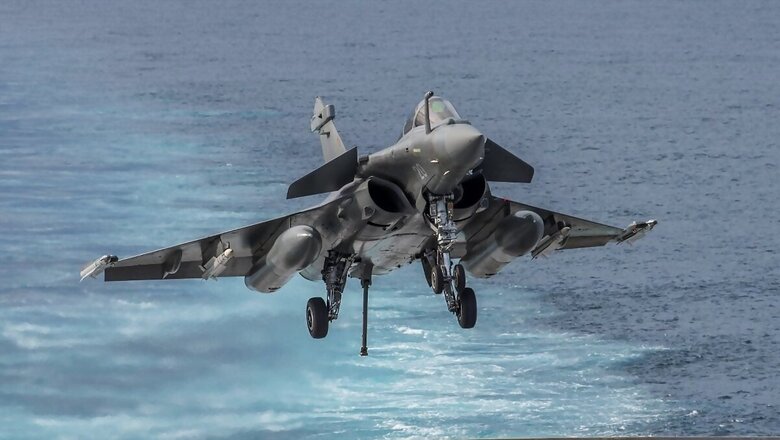
views
Overview of the Rafale M Deal
India is in advanced negotiations with France to acquire 26 Rafale Marine, or Rafale M, fighter jets which will be deployed on the Indian Navy’s aircraft carriers INS Vikrant and INS Vikramaditya. This procurement aims to operate alongside Russian MiG-29Ks and enhance the navy’s operational capabilities. The deal, expected to be finalised by the end of the financial year, underscores the strategic importance of modernising India’s naval aviation assets.
Key Differences Between Rafale M and IAF Rafale
The Rafale M, tailored for naval operations, incorporates several modifications distinct from the Indian Air Force (IAF) variant:
- Reinforced Undercarriage and Landing Gear: Designed to endure the high-impact stress of carrier landings, the Rafale M features a more robust undercarriage and reinforced landing gear. This ensures the aircraft can handle the harsh conditions of naval aviation, including arrested landings.
- Tail Hook and Jump Strut Nosewheel: Equipped with a tail hook for arrested landings and a jump strut nosewheel to facilitate catapult launches, the Rafale M can operate efficiently from aircraft carriers equipped with catapult-assisted take-off systems (CATOBAR) or ski-jump configurations (STOBAR).
- Foldable Wings: To optimise space on aircraft carriers, the Rafale M’s wings are foldable, allowing for more efficient storage and manoeuvrability within the limited confines of a carrier deck.
- Maritime-Optimised Avionics and Sensors: The Rafale M is outfitted with advanced radar systems and electronic warfare suites optimised for maritime operations. This includes anti-ship missile targeting, improved situational awareness, and electronic countermeasures tailored for naval combat scenarios.
Strategic Implications in the Indian Ocean Region
The Rafale M deal significantly enhances the Indian Navy’s capabilities to counter China’s expanding naval presence in the Indian Ocean Region (IOR). With China’s Fujian aircraft carrier featuring advanced electromagnetic catapults (EMALS) for heavier aircraft deployment, the Rafale M’s integration into the Indian Navy provides a crucial counterbalance.
- Enhanced Air Superiority and Strike Capabilities: The Rafale M, with its advanced air-to-air and air-to-surface missile systems, including the Meteor BVRAAM (Beyond Visual Range Air-to-Air Missile) and Exocet anti-ship missiles, augments the Indian Navy’s offensive and defensive prowess.
- Force Projection and Maritime Domain Awareness: The Rafale M enhances India’s ability to project power across the IOR. Its advanced sensors and avionics provide superior maritime domain awareness, enabling effective surveillance, reconnaissance, and targeting over vast oceanic expanses.
Interoperability with IAF Rafales
The selection of the Rafale M ensures seamless interoperability with the IAF’s existing Rafale fleet, leading to several strategic and operational benefits:
- Logistics: The commonality between the Rafale M and IAF Rafale reduces the complexity of supply chains. Shared components and systems mean that spare parts, ammunition, and other logistical support can be streamlined, reducing costs and improving efficiency.
- Maintenance: Technicians and engineers trained on the IAF Rafale can apply their skills directly to the Rafale M, minimising the need for extensive additional training. This results in faster turnaround times for maintenance and repairs, ensuring higher aircraft availability.
- Training: Pilots transitioning between the IAF Rafale and the Rafale M benefit from familiarisation with the aircraft’s systems and handling characteristics. This reduces the time and resources required for training, allowing for more effective utilisation of personnel and flight hours.
- Operational Efficiencies: Shared tactics, techniques, and procedures (TTPs) between the IAF and the Navy enhance joint operations. Coordinated missions, such as combined air strikes or integrated defence operations become more effective due to the standardised platform.
- Cost Savings: The economies of scale achieved through commonality in the Rafale fleet result in significant cost savings. Bulk procurement of parts and shared training programs reduce overall expenditure, allowing resources to be allocated to other critical areas.
Strategic Impact
Interoperability between the Rafale M and IAF Rafale amplifies India’s military capabilities, fostering a cohesive and integrated defence strategy. This synergy strengthens India’s deterrence posture and operational readiness, particularly in joint operations involving both air and naval forces.
Dominance in the Indian Ocean Region
The integration of Rafale M fighters will significantly bolster the Indian Navy’s ability to dominate the Indian Ocean Region (IOR). This enhanced capability allows India to maintain a formidable presence along key maritime chokepoints such as the Strait of Malacca, Sunda Strait, Lombok Strait, and Ombai-Wetar Strait. These strategic waterways are critical for global trade, including China’s maritime routes to Africa and the Middle East. By strengthening its naval aviation assets, India can effectively monitor and potentially control these chokepoints, thereby reducing Chinese influence and hegemony in the region.
- Strait of Malacca: As one of the world’s busiest shipping lanes, the Strait of Malacca is crucial for China’s energy imports from the Middle East and Africa. By deploying Rafale M fighters, India can enhance its surveillance and interdiction capabilities, potentially disrupting Chinese maritime logistics and energy supplies.
- Sunda and Lombok Straits: These alternative routes to the Strait of Malacca are also critical for Chinese maritime traffic. Indian naval presence, supported by Rafale Ms, can extend strategic deterrence, ensuring that China’s access to these routes is under constant scrutiny.
- Ombai-Wetar Strait: Vital for submarine movements and strategic military logistics, controlling this strait would enable India to monitor and counter any Chinese naval activity aimed at projecting power into the Indian Ocean or beyond.
By exerting control over these chokepoints, India can diminish China’s strategic flexibility and influence in the IOR, subsequently impacting Chinese hegemony in Africa and the Middle East. This strategic advantage not only curtails China’s naval reach but also reinforces India’s position as a dominant maritime power in the IOR, safeguarding its interests and those of its allies in the broader geopolitical landscape.
Future Scenarios and Enhanced Capabilities
Increased Surveillance and Intelligence: Advanced ISR (Intelligence, Surveillance, and Reconnaissance) capabilities provided by the Rafale M will allow the Indian Navy to track and monitor Chinese naval movements with greater accuracy. This will include the ability to detect and track submarines, surface ships, and aircraft in real time.
Strategic Deterrence: The presence of Rafale M fighters, capable of rapid deployment from carriers, will serve as a powerful deterrent against potential Chinese aggression. This includes the ability to launch pre-emptive strikes on strategic targets, thus maintaining a balance of power in the region.
Joint Operations and Multinational Exercises: The Rafale M’s capabilities will enhance India’s participation in joint naval exercises with other major naval powers, such as the United States, Japan, and Australia. This will not only improve interoperability but also send a strong message of collective security to China.
Cyber Warfare and Electronic Dominance: Equipped with cutting-edge electronic warfare systems, the Rafale M will provide the Indian Navy with the ability to jam enemy communications, disrupt radar systems, and conduct cyber operations, further neutralising Chinese technological advantages.
Conclusion
The acquisition of Rafale M fighters is a strategic move to bolster the Indian Navy’s aerial capabilities. By enhancing operational readiness and deterrence, the Rafale M deal positions India to effectively counter China’s naval ambitions and assert its influence in the Indian Ocean Region. This procurement underscores India’s commitment to maintaining maritime security and strategic stability in the region amidst evolving geopolitical dynamics.
Group Capt MJ Augustine Vinod VSM (retd) tweets at @mjavinod. Views expressed in the above piece are personal and solely that of the author. They do not necessarily reflect News18’s views.




















Comments
0 comment